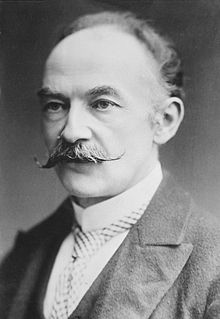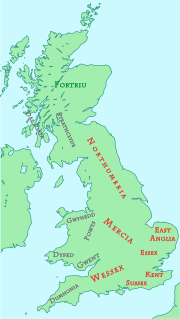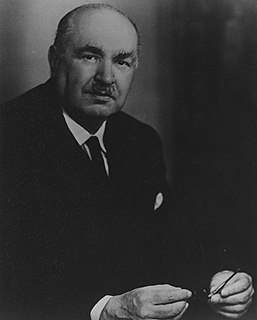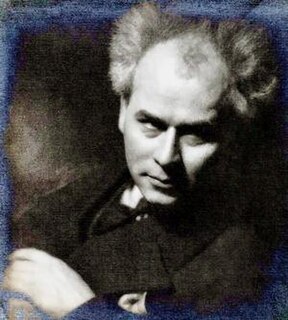
Thomas Hardy was an English novelist and poet. A Victorian realist in the tradition of George Eliot, he was influenced both in his novels and in his poetry by Romanticism, especially William Wordsworth. He was highly critical of much in Victorian society, especially on the declining status of rural people in Britain, such as those from his native South West England.

The Kingdom of the South Saxons, today referred to as the Kingdom of Sussex, was one of the seven traditional kingdoms of the Heptarchy of Anglo-Saxon England. On the south coast of the island of Great Britain, it was originally a sixth-century Saxon colony and later an independent kingdom. The South Saxons were ruled by the kings of Sussex until the country was annexed by Wessex, probably in 827, in the aftermath of the Battle of Ellandun.

George Robert Gissing was a British novelist who published 23 novels between 1880 and 1903. Gissing also worked as a teacher and tutor throughout his life. He published his first novel, Workers in the Dawn, in 1880. His best known novels, which are published in modern editions, include The Nether World (1889), New Grub Street (1891) and The Odd Women (1893).

Joseph Hilaire Pierre René Belloc was an Anglo-French writer and historian and one of the most prolific writers in England during the early twentieth century. Belloc was also an orator, poet, sailor, satirist, writer of letters, soldier, and political activist. His Catholic faith had a strong impact on his works. He was President of the Oxford Union and later MP for Salford from 1906 to 1910. He was a noted disputant, with a number of long-running feuds, but also widely regarded as a humane and sympathetic man. Belloc became a naturalised British subject in 1902 while retaining his French citizenship.

The Case-Book of Sherlock Holmes is the final set of twelve Sherlock Holmes short stories by Arthur Conan Doyle first published in the Strand Magazine between October 1921 and April 1927.
Roland Huntford is an author, principally of biographies of Polar explorers.

Anthony Mario Ludovici MBE was a British philosopher, sociologist, social critic and polyglot. He is best known as a proponent of aristocracy, and in the early 20th century was a leading British conservative author. He wrote on subjects including art, metaphysics, politics, economics, religion, the differences between the sexes, race, health and eugenics. Ludovici began his career as an artist, painting and illustrating books. He was private secretary to sculptor Auguste Rodin for several months in 1906, but the two men parted company after Christmas, "to their mutual relief." Ultimately, he would turn towards writing, with over 30 books as author, and translating many others.
Senlac Hill is the generally accepted location where Harold Godwinson deployed his army for the Battle of Hastings on 14 October 1066. It is located near what is now the town of Battle, East Sussex. The name Senlac was popularised by the Victorian historian E.A. Freeman based solely on a description of the battle by the Anglo-Norman chronicler Orderic Vitalis. Freeman went on to suggest that the Normans nicknamed the area Blood lake as a pun on the English Sand lake.
Charles WilfridScott-Giles was an English writer on heraldry and an officer of arms, who served as Fitzalan Pursuivant Extraordinary.
Scott Lash is a professor of sociology and cultural studies at Goldsmiths, University of London. Lash obtained a BSc in Psychology from the University of Michigan, an MA in Sociology from Northwestern University, and a PhD from the London School of Economics (1980). Lash began his teaching career as a lecturer at Lancaster University and became a professor in 1993. He moved to London in 1998 to take up his present post as Director for the Centre for Cultural Studies and Professor of Sociology at Goldsmiths College.
Robert Neal Rudmose-Brown was an academic botanist and polar explorer.
The Haestingas, or Heastingas or Hæstingas, were one of the tribes of Anglo-Saxon Britain. Not very much is known about them. They settled in what became East Sussex sometime before the end of the 8th century. A 12th-century source suggested that they were conquered by Offa of Mercia, in 771. They were also recorded in the Anglo-Saxon Chronicle (ASC) as being an autonomous grouping as late as the 11th century.
Colin Holmes is a British author, scholar, and historian. He retired in 1998 and is now an Emeritus Professor of History at the University of Sheffield.

Sir (Laurence) Dudley Stamp, CBE, DSc, D. Litt, LLD, Ekon D, DSc Nat, was professor of geography at Rangoon and London, and one of the internationally best known British geographers of the 20th century.

The Roll of Distinguished Philatelists (RDP) is a philatelic award of international scale, created by the Philatelic Congress of Great Britain in 1921. The Roll consists of three pieces of parchment to which the signatories add their names.
Sir Sydney Castle Roberts was a British author, publisher and university administrator. He was a well-known and popular figure around Cambridge throughout his life, and was recognised as a publisher of skill and distinction.
Bernard Mordaunt Ward was a British author and third-generation soldier most noted for his support of the Oxfordian theory of Shakespeare authorship and writing the first documentary biography of Edward de Vere, 17th Earl of Oxford.
Denzil Dean Harber was an early British Trotskyist leader and later in his life a prominent British ornithologist.

The Face of Britain was a series of topographical books published by B. T. Batsford from the 1930s to the 1950s that has been described as playing a part in the construction of English identity in that period. The series is notable for the covers by Brian Batsford who worked as Brian Cook.

Hugh Quigley was a Scottish economist, statistician, farmer, and author. His diary of his service with the 12th Royal Scots Regiment of the British Army at Passchendaele and the Somme during the First World War was published in 1928.










